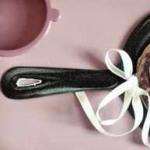Crocheted flip flops chrysanthemum. Knitted chrysanthemums
A beautiful crocheted chrysanthemum can serve as a brooch or simply decorate the interior.
You will need:
YarnArt Tulip and hook 1.3.
The flower consists of 4 tiers. Each one starts with a circle, worked into a sc; petals are knitted along the edge using the Tunisian technique (one petal - one row). The finished part with petals is tied around the perimeter of the stbn with wire. First tier 6-12; 6 petals 10 vp high. Second tier 6-12-18; 9 petals 11 vp high. Third row 6-12-18-24; 12 petals 12 vp high. Fourth tier 6-12-18-24-30; 15 petals 13 vp high. The diameter of the flower is approximately 8 cm.
Answers on questions:
What is "First tier 6-12"?
Number of columns in circular rows. The initial row is made of six single crochet stitches (the initial row stitches are usually knitted in a sliding loop, the so-called “amigurumi loop”). In the next row, knit two stitches in each loop. It turns out to be a small circle, along the edge of which the petals are evenly knitted. As a rule, I knit a stitch using both half-loops. There are simply four separate tiers.
After knitting the last (in this case, the only) Tunisian row, go down to the base of the petal with connecting posts. We insert the hook into the nearest Tunisian post from right to left, grab the thread, pull it through the post and through the loop on the hook. One connecting post is ready. In short, proceed in the same way as when casting off the final row when knitting.
Join our groups - there is even more interesting stuff:
I apply the wire to the edge of the part and knit the next row with regular single crochets. The wire turns out to be “hidden” inside the loops. Here is a large image (though this is not a petal, but a leaf):
I knit hats professionally.
I like to come up with new models and write descriptions for them.
Knitted hat "Chrysanthemum" is one of my favorite patterns.
But for some reason there is not much interest in her. Probably because the description is publicly available. But the description was made a long time ago, since then I have little secret: how to make sure that the brim of the hat does not skew, as happened before.
Take a look and notice the difference.
I invite everyone to knit my favorite hat about me!
Usually I make sequential descriptions, but since there are many people who want to knit a hat, and everyone’s density is different, I won’t describe them in rows.
You will need:
200g yarn 250 - 300m/100g
Hook No. 4, No. 5, No. 3.
Abbreviations:
V.p. – air loop
Sc – single crochet
CC – connecting post
СС1н - double crochet
SS2n - double crochet stitch
Also, when knitting a hat, convex single crochets are used.
Description:
Size 56.
The hat is knitted from top to bottom. Knit a hat in 2 threads, knit a flower in one thread!!!
The bottom of the hat
Tie with single crochet stitches in a spiral (without closing the circular row with a connecting stitch)
crochet number 4 circle diameter 19 cm for the bottom of the hat.
Mark the beginning of each round with a marker or contrasting thread.
If your size is larger than 56, increase the diameter of the circle by 0.7 - 1 cm when increasing the size (57 - 20 cm, etc.)
*** If you want the hat to be loose at the top, knit the bottom 1 cm more: 20 cm for size 56, etc. .*** I like this option better.
Finish the last row of the bottom with a connecting post to close the circular row.
Tulya(flat part of the hat)
Work approximately 7 cm in single crochet stitches in circular rows, ending the circular row.
Start each new row with a 1ch rise and end with a connecting stitch.
***
Knitting the crown in circular rows with the circle closed will eliminate the distortion of the knitted fabric.
The flower is sewn on the seam formed when closing the circular row, so you don’t have to worry about your seam not looking perfect. ***
Crochet single crochet in circular rows with row closure. Smooth seam. http://shapkidesign.ru/blog.php?user=olga9172&blogentry_id=1363
Try on a hat. The last (bottom) row should be approximately 2 cm below the top of the ear. Cut the thread.
Determine a place for the flower. The flower is supposed to be made on the side; it will cover the seam formed during the transition to a new row.
Mark the middle of the back of the hat - this will be the beginning of the next round.
Attach the thread to the marked place.
Continue knitting in circular rows, closing the row with a connecting stitch.
Knit 3 rows with convex sc. crochet number 3.
4 rows with convex sc crochet number 4.
4 rows with convex sc crochet number 5.
Convex single crochet.
Insert the hook from right to left under the leg of the next column of the previous row from the front side, yarn over the hook and pull the thread from left to right under the leg of the column, knit 2 loops on the hook.
Along the edge of the hat on the front side, tie a row of connecting posts with a No. 5 crochet hook.
Tie a row with connecting posts along the line between the last row of sc and the first row of convex posts.
Flower
The flower consists of 4 parts, which are knitted separately, then overlapped and sewn into the hat.
Crocheting or knitting flowers is not only an exciting hobby, but also an opportunity to get a unique accessory.
Multilayer chrysanthemum is a rather difficult flower to knit, requiring certain skills from the handmaker. However, the result is worth the effort - bright flower will be an excellent decoration for clothes or hair. See below for chrysanthemum crochet patterns.
Daisies look best when there are several of them. A row of daisies can decorate the collar of a jumper, or use it as a belt or headband. White flowers with sunny centers will set a cheerful summer mood anywhere.
Rose is the flower of lovers. That is why a knitted accessory depicting this flower is suitable for an evening out. Pin one or three flowers to the lapel of your blouse - this will add a romantic style to your outfit and make it original.
A light, elegant dahlia is suitable for decorating a daytime outfit. It will look great in dark, flowing hair or on the lapel of a blouse. Contrasting beads in the middle of the flower will highlight and highlight the whiteness of the petals.
Below you will see crocheting patterns for chamomile, rose and dahlia.

Lush poppy of bright red color is perfect would be better suited for black clothes. By playing with contrast, you can add ethnic Latin motifs to any outfit. In the evening, it would be appropriate to pin a poppy to the hair above the ear or decorate a high ponytail with it.
Light and airy magnolia will look great in the hair of a young girl. The lace petals go perfectly with the bright beads in the center of the flower. Together they create a fresh ensemble and symbolize youth and purity. See diagrams for these colors.

A poppy necklace would be appropriate on a thick, plain winter sweater. Pastel muted tones of petals go well with bright pink flower and together serve as a reminder of warmth. A little summer on a cold winter day - what more do you need?
Description of knitting this necklace.

A magical bouquet is an excellent decoration for a child’s winter hat. A large, bright flower with spreading petals will make a girl feel elegant even on a gray winter day. For small child It’s better to knit a looser flower so that it doesn’t weigh down the hats.

I knit hats professionally.
I like to come up with new models and write descriptions for them.
Knitted hat "Chrysanthemum" is one of my favorite patterns.
But for some reason there is not much interest in her. Probably because the description is publicly available. But the description was made a long time ago, since then I have a little secret: how to make sure that the brim of the hat does not warp, as happened before.
Take a look and notice the difference.

You can see the color combinations for the hat here. http://www.stranamam.ru/album/6088772/
Photo finished works
http://www.stranamam.ru/album/8074321/
I invite everyone to knit my favorite hat about me!
Usually I make sequential descriptions, but since there are many people who want to knit a hat, and everyone’s density is different, I won’t describe them in rows.
You will need:
200g yarn 250 - 300m/100g
Hook No. 4, No. 5, No. 3.
Abbreviations:
V. p. - air loop
Sc - single crochet
CC - connecting post
СС1н - double crochet
SS2n - double crochet stitch
Also, when knitting a hat, convex single crochets are used.
Description:
Size 56.
The hat is knitted from top to bottom.Knit a hat in 2 threads, knit a flower in one thread!!!
The bottom of the hat
Tie with single crochet stitches in a spiral (without closing the circular row with a connecting stitch)
crochet number 4 circle diameter 19 cmfor the bottom of the hat.
Mark the beginning of each round with a marker or contrasting thread.

If your size is larger than 56, increase the diameter of the circle by 0.7 - 1 cm when increasing the size (57 - 20 cm, etc.)
***
If you want the hat to be loose at the top, knit the bottom 1 cm more: 20 cm for size 56, etc. .***
I like this option better.
Link to the tutorial on Knitting a circle for the bottom of a hat in the comments.
Finish the last row of the bottom with a connecting post to close the circular row.
Tulya(flat part of the hat)
Work approximately 7 cm in single crochet stitches in circular rows, ending the circular row.
Start each new row with a 1ch rise and end with a connecting stitch.
***
Knitting the crown in circular rows with the circle closed will eliminate the distortion of the knitted fabric.
The flower is sewn on the seam formed when closing the circular row, so you don’t have to worry about your seam not looking perfect.***
Crochet single crochet in circular rows with row closure. Smooth seam. http://shapkidesign.ru/blog.php?user=olga9172&blogentry_id=1363
Try on a hat. The last (bottom) row should be approximately 2 cm below the top of the ear. Cut the thread.
Determine a place for the flower. The flower is supposed to be made on the side; it will cover the seam formed during the transition to a new row.
Mark the middle of the back of the hat - this will be the beginning of the next round.
Attach the thread to the marked place.
Continue knitting in circular rows, closing the row with a connecting stitch.
Knit 3 rows with convex sc.crochet number 3.
4 rows with convex sccrochet number 4.
4 rows with convex sccrochet number 5.
Convex single crochet.
Insert the hook from right to left under the leg of the next column of the previous row from the front side, yarn over the hook and pull the thread from left to right under the leg of the column, knit 2 loops on the hook.
Along the edge of the hat on the front side, tie a row of connecting posts with a No. 5 crochet hook.
Tie a row with connecting posts along the line between the last row of sc and the first row of convex posts.
Flower
The flower consists of 4 parts, which are knitted separately, then overlapped and sewn into the hat.
Summer hat crocheted with white yarn. Decorate the hat decorative flower And satin ribbon, threaded through the holes of the pattern.
Size: single
You will need: about 100g yarn white;
Hook No. 2
Patterns
Fantasy pattern: knit by scheme
Abbreviations used:
V. p. - air loop
Conn. Art. – connecting column;
RLS – single crochet;
С1Н – double crochet;
С2Н - double crochet stitch
Description of knitting
Crochet a chain of 8 sts. p. and close it into a ring connection. Art.
1st row: 30 C1H
2nd r.: 3 c. p. lifting 2 in. p., * C1H, 2 v. p. *, repeat from * to * 14 times
Starch the hat by turning the edges, as shown in the photo. Thread a satin ribbon into the holes of the pattern and decorate with a decorative flower.
Crocheted bonnet and scarf

Size: 56.
You will need:
250 g of yarn (PAN, “Helena”);
hook No. 2.
Technique: crochet.
Basic bouclé pattern: crochet according to pattern 19.1.
Knitting density: 7 repeats x 16 rows = 10 x 10 cm.
Model pattern: 


Description of work:
Execution of work: knit the bottom (A) according to the pattern, start from the narrow edge (= chain of 12 chain stitches + 3 chain stitches rise) and knit with the main pattern according to pattern 19.1, gradually expanding to the 20th row to 30 stitches Then knit the part covering the head (B), start from the lower wide edge (= chain of 111 chain stitches + 3 chain stitches in rise) and knit with the main pattern according to pattern 19.1, gradually reducing the number of loops on both sides, to For the 20th row, decrease to 93 sts. The length of sides a, b, and a1 should be equal to the length of the perimeter of the bottom without the length of its lower part. Connect the connected parts along the front side (at the same time, slightly gather the bottom at the top) using a hook with one row of single crochets and 1 row of “ crayfish step“. Along the edge of the front part of the cap, knit the fields (C) with the main pattern, evenly increasing the number of loops to 150 (= 50 repeats). For side bevels on both sides, decrease by 1 stitch in each row. At a height of 6 cm from the beginning, finish the work, tie the fields without side bevels in a “crawfish step.”
Bow: knit a rectangle with the main pattern according to pattern 19.1, starting from the short side (= 18 v. p. + 3 v. p. rise), 12 cm long. Pull it in the middle with a thread, tie it with a “crawfish step”. Sew the middle of the bow to the middle of the bottom, and the edges to the part that covers the head.
Scarf.
Size: 26 x 135 cm.
Doing the job: tie a chain of 60 v. p. + 3 v. p. rise and knit with a pattern according to pattern 19.2. When finished, tie around the perimeter: 1st row - s/n columns; 2nd row - *1 tbsp. s/n, skip 2 tbsp. previous row, 2nd century. P.*. Tie fringe along the narrow edges according to pattern 19.3. On the long sides, knit 1 row in a crawfish step.
Source: newsletters -darievna.ru



HERE IS ANOTHER DESCRIPTION OF THIS PANAMACHKA
Panama hat for girls "Chamomile" - Knitting
According to scheme 1, make the core of the flower with thread yellow color. Next, tie 12 petals according to pattern 2 with white thread. Connect all the petals together as follows: when the last petal is completed, then, without breaking the thread, take the 1st petal and tie it on three sides. b/n. (one long side, round and one long side). So connect all the petals to each other sequentially one after another. When the entire chamomile is tied along the contour, perform the second row of tying c. b/n. Sew the core in the center of the daisy. Tie chamomile petals around the edge:
1 rub. - 10 vp each between petals, 2 s. b/n at the top of the petal;
2 r. - 3rd century p. rise, knit a fillet mesh, alternating 2 v.p. and 1 s.n. throughout the entire row;
3 r. - 3 v.p. rise, 2 s. n. under the arc of the previous row, 1 s.n. in the column of the previous row, 2 vp, 1 dc. in the same column of the previous row, 2 d.s. to the next arc of the previous row, 1 s. n. in the column of the previous row, 2 in. etc. and so on until the end of the row;
4 rub. - loin mesh(like row 2). Tie the crown of the hat with a pattern according to the pattern shown in Fig. 3. The number of rows depends on the desired size of the product. Work approximately 16 rows. For a full hat, tie 11 daisies with 9 petals each.
To make the fields, connect 11 daisies as you make them. Next, proceed to connecting the brim and crown of the hat with a crochet hook or needle and thread. Connect the petals along the edge of the product with neat chains of air loops, as well as single crochets.
You need to connect 11 daisies for the fields while knitting them. To ensure that the daisies fit correctly in a circle, make a template according to the size of the circle and connect the daisies on this template. When all 11 daisies are tied and connected to each other, proceed to connecting the brim and crown of the hat. Choose a method convenient for you and connect the parts with a crochet hook or a needle and thread. Along the edge of the cap, connect the petals together with chains of... p. and s. b/n. (look at the photo). 



The model is made with crochet.
You will need: 150 g of Vista yarn - equal parts blue and dark blue, a little light green and light green; wire; hook No. 2.5.
Knit sc in circle (diagram 10): 6 rub. - light green color, 1 rub. - blue, 1 rub. - light green, 1 rub. - green,
Sp. - blue.
Then knit without increments: 4 r. - blue, 4 r. - light green, 1 rub. - blue.
Then knit 2 p. drawn loops (Fig. 96).
Tie a wire circle and attach it to the brim. Sew the brim onto the cap along the edge of the openwork strip.
Model by Olga Semikina based on materials from the fashion magazine "HATS" No. 455.
Scheme




The model is crocheted.
You will need: 150 g cotton yarn; hook No. 2.
Tie a hat by scheme 69, starting from a ring of 6 VP, and, using hard starch, dry it on a mold.
Model by Vera Kulikovskaya based on materials from the fashion magazine "HATS" No. 455
Scheme




Hat crocheted

Materials:
100 g melange yarn"Paglia di Fiesole" Manifattura Mafil di Ro magna no Sesia
Hook No. 5.
Types of loops:
VP - air loop
conn. Art. – connecting post
sc - single crochet
sen - double crochet.
Description of work.
Using crochet hook No. 5, cast on 4 ch and close the connection in a circle. Art. 1st circle. R.: in the resulting ring, perform 8 sc (replace the 1st sc in each row with 1 ch, and the 1st sen with 3 ch, finish this row and the next rows of connecting stitches in the loop of the beginning of the row).
2nd circle. r.: 2 sc in each st.
3rd and 5th circle, p.: *1 Sep, next. p. knit 2 Sep*, rep.
between **.
4th circle. r.: sbn.
6th circle, r.: *2 sc, next. p. knit 2 sc*, rep. between **.
7th circle, r.: *Sep 5, next. p. knit 2 Sep*, rep. between
**
8th circle. r.: sbn.
9th and 11th circle, p.: *8 Sep, next. p. knit 2 Sep*, rep. between **.
10, 12, 14, 18, 20 and 22nd circle, r.: sc. 13th, 15th and 23rd circle, r.: Sep.
16th circle, row: *2 sc, next. p. knit 2 sc*, rep.
Sbetween **. 17th circle, r.: *Sep 3, next. p. knit 2 Sep*, rep. between **.
19th circle, row: *4dc, next. p. knit 2 Sep*, rep. between **.
21st circle, r.: *10 Sep, next. p. knit 2 Sep*, rep. between **.
Cut the thread and finish the job.
White crochet beret (clickable diagram)


Summer hat Yu_Yu






















Tips for making crochet hats

Most often, crocheted hats are knitted from the top (from the crown) down in the round.
The circle begins to be knitted from the center, making increases in a certain order. There are several fairly common forms of hats.
Laws of the flat circle
1 law. If the circle is knitted st. b/n, then start at 1 p.m. from 6 tbsp. b/n, divide the circle into 6 wedges and add 6 columns in each row-circle.
2nd law. If the circle is knitted p/st., then start in the 1st r. with 8 stitches, divide the circle into 8 wedges and make 8 increases in each row.
3 law. If the circle is knitted st. s/n, then start on the 1st day. from 12th century s/n, divide the circle into 12 wedges and make 12 increases in each row.

Increases can be made in several ways:
1 way. The increase is always performed on the last column of the wedge. You will get symmetrical wedges with a noticeable line of increases between them.
Method 2. The increase is always performed on the first column of the wedge. The result will be asymmetrical wedges, slightly curved to the right, with a noticeable line of increases between them.
3 way. Increases are made in each wedge so that they are not located on top of each other. The result will be a flat circle with no visible increase lines.
Which method of performing increments to choose depends on your desire and the planned model.
1. Classic round cap.
Using the selected stitches, knit a flat circle with a diameter of 12 cm, making increases in each row. Then an increase is made through the row to the desired hat size, equal to the circumference of the head (Og). Next, knit without increments to the required height of the hat.
2. The cap is slightly elongated.
The selected stitches are used to knit a circle, but with fewer increases. If knit st. b/n, then start on the 1st day. from 5 tbsp. b/n and make 5 increases in each row. If knit st. s/n. then start with 10 tbsp. s/n in 1st r. and make 10 increases in each row. And so they knit until the desired head circumference. Next, knit without increments to the desired height of the hat.
3. Kubanka cap.
Using the selected stitches, knit a flat circle to the desired head circumference. The diameter of the circle is equal to the circumference of the head divided by 3. Next, knit without increases to the desired height.

Increases for hats, practical tips








